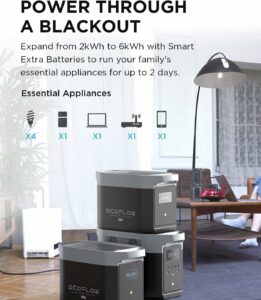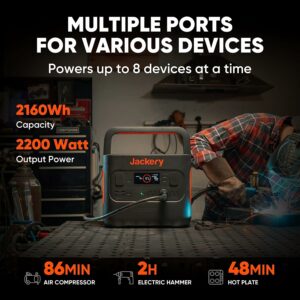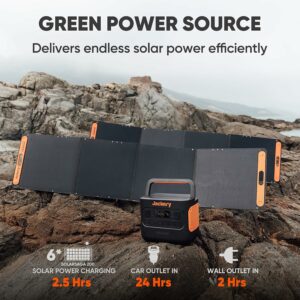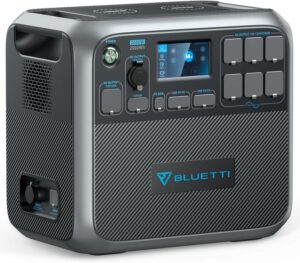Harness the Power of Solar Generators for Sustainable Energy Solutions
Introduction to Solar Generators
Definition and Explanation:
- Solar generators are devices that harness energy from the sun and convert it into electricity for various applications. They operate on the principle of photovoltaics, where sunlight is captured and transformed into usable power.
- The core components of a solar generator include solar panels, which capture sunlight; an energy storage system, typically comprising batteries; and inverters that convert the captured DC (direct current) into AC (alternating current) electricity.
Brief History of Solar Energy:
- Solar energy has been utilized for centuries, but the modern era of solar power began in the mid-20th century. The development of photovoltaic technology in the 1950s paved the way for more efficient and practical solar generators.
- Over the years, materials and manufacturing advancements have significantly improved solar panels’ efficiency and affordability, making solar energy a viable and increasingly popular power source.
Importance of Sustainable Energy Solutions:
- As the world faces environmental challenges and seeks alternatives to traditional fossil fuels, sustainable energy solutions like solar generators are crucial in reducing carbon footprints and mitigating climate change.
- Solar generators contribute to a cleaner and more sustainable energy future by harnessing an abundant and renewable resource – the sun – thereby reducing dependence on non-renewable energy sources.
Provo Green Products embodies a beacon of trust in sustainable discoveries, offering choices that enhance your life and leave a positive mark on our planet.
Leveraging extensive expertise in manufacturing, construction, and various trades, we provide a solid foundation for sustainable living.
Our meticulous research process guarantees that our information about each product is precise and current, allowing you to make informed decisions.
Whether your interest lies in solar products, electric bikes, or other eco-friendly alternatives, our commitment to credibility ensures you have access to dependable insights, guiding your journey toward a more sustainable lifestyle.
Provo Green Products is your go-to destination for finding the right green products for your lifestyle.
Disclosure: As an Amazon Associate, we may earn from qualifying purchases. This does not affect the product pricing whatsoever.
Key Components of Solar Generators
- Solar Panels: How They Work
- Photovoltaic Cells: Solar panels consist of photovoltaic cells made of semiconductor materials like silicon. When sunlight hits these cells, it excites electrons, generating direct current (DC) electricity.
- Panel Types: There are various types of solar panels, including monocrystalline, polycrystalline, and thin-film. Each type has its characteristics, affecting efficiency, cost, and space requirements.
- Energy Storage Systems
- Batteries: Solar generators use batteries to store excess energy generated during periods of sunlight. Common types include lead-acid, lithium-ion, and saltwater batteries, each with advantages and limitations.
- Capacity and Efficiency: The battery’s capacity determines how much energy can be stored. Advances in battery technology are crucial for improving solar generator systems’ overall efficiency and reliability.
- Inverters and Controllers
- Inverters: The direct current produced by solar panels must be converted into alternating current for most household and industrial applications. Inverters perform this conversion, ensuring compatibility with standard electrical devices.
- Charge Controllers: These devices regulate the charge going into the batteries, preventing overcharging and optimizing the charging process. They play a critical role in extending battery life.
Understanding these key components provides insight into the inner workings of solar generators.
The efficiency and reliability of each component contribute to the overall effectiveness of a solar generator system.

Advantages of Solar Generators
Environmental Benefits
- Reduced Carbon Footprint: Solar generators produce electricity without emitting greenhouse gases, helping to mitigate climate change. Unlike fossil fuels, solar power does not contribute to air pollution or carbon dioxide emissions.
- Renewable and Sustainable: Solar energy is a renewable resource that is virtually inexhaustible. Harnessing solar power reduces dependence on finite fossil fuels, promoting long-term environmental sustainability.
Cost Savings Over Time
- Lower Operating Costs: Solar generators have minimal operating and maintenance costs once installed. Unlike traditional power sources, there are no fuel costs or ongoing expenses related to extracting, transporting, and burning fossil fuels.
- Return on Investment (ROI): While the initial investment for solar generator installation can be significant, it often pays off over time through lower electricity bills and potential incentives, contributing to a positive ROI.
Independence from Grid Power
- Off-Grid Capability: Solar generators can function independently of the grid, providing a reliable power source in remote areas or during grid outages. This independence is particularly valuable for off-grid residences, emergencies, and outdoor activities.
- Grid Backup: Solar generators can be a backup during power outages in grid-tied systems with battery storage, ensuring a continuous power supply for essential appliances and devices.
These advantages highlight solar generators’ positive environmental impact, financial savings, and reliability.
Applications and Use Cases
Residential Solar Generator Systems:
- Home Energy Independence: Solar generators empower homeowners to generate electricity, reducing reliance on the conventional grid. This is particularly valuable in regions with intermittent power or high energy costs.
- Backup Power: Residential solar generators often include battery storage, offering a reliable backup power source during grid outages. This ensures continuous electricity for essential appliances and devices.
Commercial and Industrial Use:
- Energy Cost Reduction: By incorporating solar generators, businesses can significantly lower their operational costs. The reduced reliance on grid power leads to decreased electricity expenses over the long term.
- Environmental Responsibility: Adopting solar generators aligns with corporate sustainability goals, demonstrating a commitment to environmentally friendly practices and reducing the carbon footprint.
Portable Solar Generators:
- Outdoor Activities: Portable solar generators are ideal for camping, hiking, and other outdoor activities. They provide a convenient and eco-friendly power source for charging electronic devices, running lights, and powering small appliances.
- Emergency Preparedness: Compact and easily transportable, portable solar generators serve as valuable tools in emergencies, ensuring access to electricity for communication devices, medical equipment, and lighting.
The versatility of solar generators makes them applicable in various settings, ranging from individual homes to large-scale industrial operations.
Each application addresses specific needs, emphasizing solar generator systems’ adaptability and broad utility.

Challenges and Future Trends
Current Limitations of Solar Generators:
- Intermittency: One challenge is the intermittent nature of solar power. Solar generators depend on sunlight, making them less effective during cloudy days or at night. Advances in energy storage technology aim to address this limitation by enhancing the ability to store and retrieve energy efficiently.
- High Initial Costs: The upfront costs of purchasing and installing solar generator systems can be a barrier for some individuals and businesses. However, ongoing technological advancements and government incentives are gradually mitigating this challenge.
Ongoing Technological Innovations:
- Efficiency Improvements: Researchers and engineers are continually working on improving the efficiency of solar panels to capture more sunlight and convert it into electricity. This includes advancements in materials, design, and manufacturing processes.
- Energy Storage Solutions: Innovations in battery technology play a pivotal role in overcoming the intermittency of solar power. Enhanced energy storage solutions, such as high-capacity and longer-lasting batteries, contribute to a more reliable and consistent power supply.
The Future of Solar Energy in Sustainable Solutions:
- Integration with Other Energy Sources: The future sees an increased integration of solar energy with other renewable sources, creating hybrid systems for more reliable and consistent power generation. Solar with wind or hydropower can help balance energy production.
- Smart Grid Technologies: The development of smart grid technologies enables better management and distribution of solar power. This includes real-time monitoring, demand-response systems, and grid integration strategies to enhance efficiency.
Addressing current challenges and embracing future trends in solar generator technology is pivotal for maximizing the potential of solar energy as a sustainable power source.

Conclusion
The power of solar generators stands as a beacon of hope in the quest for sustainable energy solutions.
As we navigate the intricate landscape of photovoltaic technology and its applications, solar generators’ environmental benefits, cost-effectiveness, and versatility become increasingly evident.
Despite challenges like intermittency and initial costs, ongoing technological innovations promise a brighter future.
The journey towards energy independence and environmental stewardship is propelled by the continued refinement of solar generators and their seamless integration into diverse settings, from residential homes to industrial complexes.
Stay in Touch!
I’am a dedicated entrepreneur with many years of experience and an integrity-driven individual who is highly motivated to succeed. Leveraging extensive expertise in manufacturing, construction, and various trades, we can provide a solid foundation for sustainable living. Our meticulous research process guarantees that our information about each product is precise and current, allowing you to make informed decisions. A deep understanding of business operations empowers me to consistently implement improvements that result in ongoing success. Visit site.



